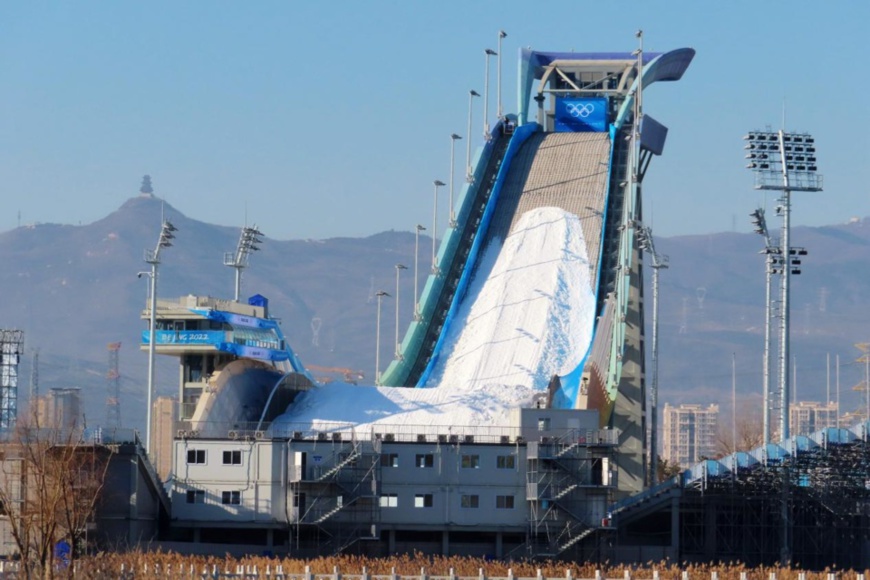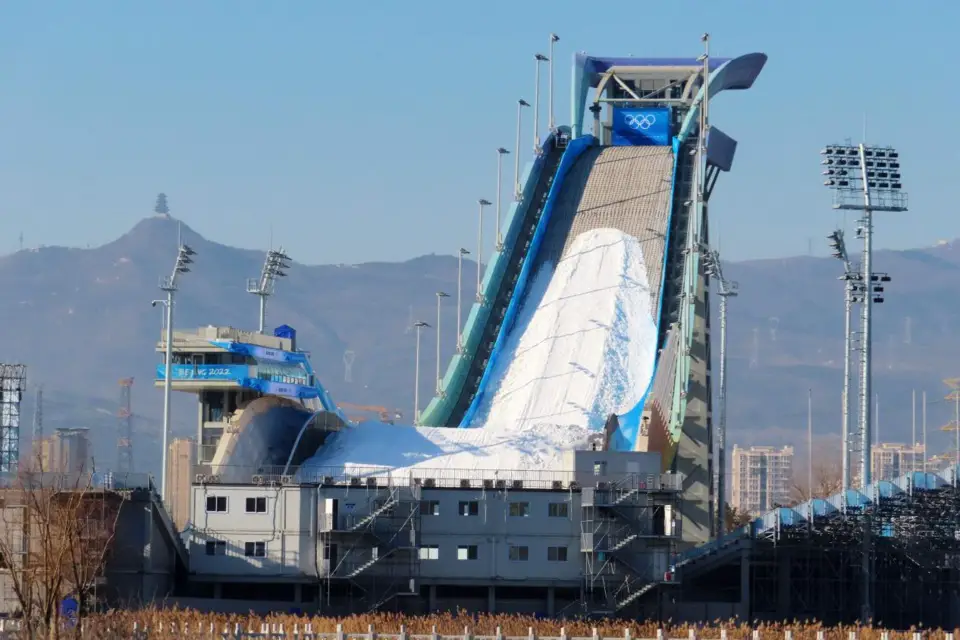By Jin Hongli

Photo taken on Jan. 3, 2022 shows the job site of snowmaking and piste shaping at the Big Air Shougang, a ski jump platform built in Shijingshan district, Beijing, for the 2022 Winter Olympic Games. (Photo by He Luqi/People’s Daily Online)
As the Beijing 2022 Winter Olympic Games approaches with each passing day, preparatory work at the Big Air Shougang, a ski jumping platform built in Shijingshan district, Beijing, for the sports event, is in full swing. The snowmaking team of the venue has already started to produce snow and shape the ski runs.
The Big Air Shougang, the only competition venue for snow sports located in the urban area of Beijing, will host competitions of two Olympic snow sports—freestyle skiing and snowboarding, in which a total of four gold medals will be awarded to winners.
To produce snow in urban areas, relevant workers must pay close attention to local weather. Generally speaking, dry and cold weather is more suitable for snowmaking, preferably with a temperature of minus 2 degrees centigrade or below.
The temperature in urban areas is high during the day, and won’t drop until the night falls. Therefore the snowmaking work can only be carried out between night and the wee hours of the next day when the temperature satisfies the requirements.
The snowmaking team needs to give close attention to major factors concerning weather conditions, such as temperature and humidity, in real time, and adjust relevant equipment based on changes in these factors to guarantee the production of high-quality snow for competitions.
Besides, snowmaking personnel have to check the pistes now and then and adjust the angle of snowmaking machines in time according to the wind direction to ensure that the artificial snow falls to the desired position.
Different sections of the ski jumping platform require different amounts of snow. The starting section will be paved with 0.5-meter-thick snow while the thickness of snow at the take-off and landing sections varies from 0.5 meters to 4 meters.
Through a winch system at the starting point of the piste, the snowmaking team places snowmaking machines at predetermined positions and then connects them to power supplies and water pipes installed during the construction of the ski jumping platform. After that, the team sets in motion the pump house to transfer water to snowmaking machines which can eventually convert water into snow.
The quality of the water used for snowmaking determines the quality of the artificial snow. Snow with impurities melts quickly, which is bad for the shaping of ski tracks and competitions.
The snowmaking system of the Big Air Shougang has two layers of filters. They can remove tiny particulate impurities from water and make it cleaner and purer, thus guaranteeing that the quality of snow produced reaches the standard for competitions.
Unlike ski resorts that use soft and loose powder snow, the Big Air Shougang chooses harder icy snow, which enables athletes to glide with less friction and makes it easier to perform maneuvers in the air.
Besides, the ski jumping platform also adjusts the moisture of snow as is needed. In principle, the lower layer of snow is wetter so that it can cling to the snow retaining nets while the upper layer is dryer for the purpose of piste shaping.
By changing the gears in the snowmaking machines, the snowmaking team is able to produce dry powder snow and wet snow with different water contents, and adjust the water output and air output to achieve precise control of snow quality.
The snowmaking work at the Big Air Shougang began in December 2021 and is expected to be finished by late January 2022. It mainly includes four stages, i.e., snowmaking for pistes, snow storage, piste shaping, as well as snow replenishment during the second round of piste shaping.
A total of 11,500 cubic meters of snow is expected to be produced during the process. The snowmaking area of the Big Air Shougang will reach about 4,190 square meters, and the snow storage zone of the venue covers an area of 1,000 square meters.
It should also be noted that the snow storage area has been equipped with a scientific research team, which makes use of technologies to reduce the heat exchange between the stored snow and air, thus cutting snow loss and guaranteeing snow replenishment during competitions.
(The author is the deputy logistics director of the venue operation team of Big Air Shougang.)
The Big Air Shougang, the only competition venue for snow sports located in the urban area of Beijing, will host competitions of two Olympic snow sports—freestyle skiing and snowboarding, in which a total of four gold medals will be awarded to winners.
To produce snow in urban areas, relevant workers must pay close attention to local weather. Generally speaking, dry and cold weather is more suitable for snowmaking, preferably with a temperature of minus 2 degrees centigrade or below.
The temperature in urban areas is high during the day, and won’t drop until the night falls. Therefore the snowmaking work can only be carried out between night and the wee hours of the next day when the temperature satisfies the requirements.
The snowmaking team needs to give close attention to major factors concerning weather conditions, such as temperature and humidity, in real time, and adjust relevant equipment based on changes in these factors to guarantee the production of high-quality snow for competitions.
Besides, snowmaking personnel have to check the pistes now and then and adjust the angle of snowmaking machines in time according to the wind direction to ensure that the artificial snow falls to the desired position.
Different sections of the ski jumping platform require different amounts of snow. The starting section will be paved with 0.5-meter-thick snow while the thickness of snow at the take-off and landing sections varies from 0.5 meters to 4 meters.
Through a winch system at the starting point of the piste, the snowmaking team places snowmaking machines at predetermined positions and then connects them to power supplies and water pipes installed during the construction of the ski jumping platform. After that, the team sets in motion the pump house to transfer water to snowmaking machines which can eventually convert water into snow.
The quality of the water used for snowmaking determines the quality of the artificial snow. Snow with impurities melts quickly, which is bad for the shaping of ski tracks and competitions.
The snowmaking system of the Big Air Shougang has two layers of filters. They can remove tiny particulate impurities from water and make it cleaner and purer, thus guaranteeing that the quality of snow produced reaches the standard for competitions.
Unlike ski resorts that use soft and loose powder snow, the Big Air Shougang chooses harder icy snow, which enables athletes to glide with less friction and makes it easier to perform maneuvers in the air.
Besides, the ski jumping platform also adjusts the moisture of snow as is needed. In principle, the lower layer of snow is wetter so that it can cling to the snow retaining nets while the upper layer is dryer for the purpose of piste shaping.
By changing the gears in the snowmaking machines, the snowmaking team is able to produce dry powder snow and wet snow with different water contents, and adjust the water output and air output to achieve precise control of snow quality.
The snowmaking work at the Big Air Shougang began in December 2021 and is expected to be finished by late January 2022. It mainly includes four stages, i.e., snowmaking for pistes, snow storage, piste shaping, as well as snow replenishment during the second round of piste shaping.
A total of 11,500 cubic meters of snow is expected to be produced during the process. The snowmaking area of the Big Air Shougang will reach about 4,190 square meters, and the snow storage zone of the venue covers an area of 1,000 square meters.
It should also be noted that the snow storage area has been equipped with a scientific research team, which makes use of technologies to reduce the heat exchange between the stored snow and air, thus cutting snow loss and guaranteeing snow replenishment during competitions.
(The author is the deputy logistics director of the venue operation team of Big Air Shougang.)
 Menu
Menu
 Ski jumping platform in Beijing busy with snowmaking for 2022 Winter Olympic Games
Ski jumping platform in Beijing busy with snowmaking for 2022 Winter Olympic Games
















